Mary Hoffman's Blog, page 14
May 19, 2012
Reading others' writing
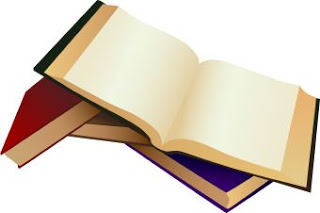 Not published books; that goes without saying. Any writer without tottering heaps by their bedside, a serious shortage of shelf space and a library card, is one I wouldn't trust.
Not published books; that goes without saying. Any writer without tottering heaps by their bedside, a serious shortage of shelf space and a library card, is one I wouldn't trust.No, this time I'm talking about the practice, increasingly common of belonging to a writers' group and/or being (and having Beta-readers).
In recent months, I have read and commented on books by at least four writer-friends ranging from an 8,000-word series book for juniors to a 150,000-word novel for adults. The writers have all been much published and some have won prizes but for some reason or another needed a second eye or more on their typescripts.
And last week I helped a writer-friend re-write a synopsis for a publisher.
But the traffic doesn't all go one way. If you are a Beta-reader, you may also need one or more. This is Wikipedia's definition:
"A beta reader ... is a person who reads a written work, generally fiction, with what has been described as "a critical eye, with the aim of improving grammar, spelling, characterization, and general style of a story prior to its release to the general public."
The author or writer, who can be referred to as the alpha reader, may use several "betas" prior to publication. The term "beta" is an appropriation from the software industry which uses the terms "alpha" and "beta" for software that are internal works in progress and publicly released tests, respectively (though a "beta" version may still be tested internally). While the use of the concept and the term is most common among fan fiction writers, it is growing in popularity with novelists, to the point where some have thanked their beta readers (sometimes even referring to them as such) in their acknowledgments. A beta reader, who may or may not be known to the author, can serve as proofreader of spelling and grammar errors or as a traditional editor, working on the "flow" of prose. In fiction, the beta might highlight plot holes or problems with continuity, characterisation or believability; in fiction and non-fiction, the beta might also assist the author with fact-checking."
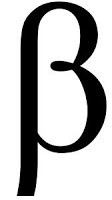
It's hard for someone who prides herself on her grammar, punctuation and vocabulary to take 'editing' from anyone else. This is difficult enough when it comes from a Commissioning or Copy editor, especially if their suggestions result in something the writer considers to be introduced errors. But from friends! And about crucial issues of plot!
I belong to a book group and to many writers' organisations, ranging in degrees of formality. But I don't have a writers' group as such, where we exchange passages of Works in Progress for comment. I know people who do this regularly and admire their courage.
What I have is lots of writer friends. They ask me for comments and recently I have been brave enough to ask them for theirs.
It was because I had written an adult novel. The main character was thirty, which I have been in my time but not in 2008, when her thirtieth birthday very specifically occurred. Did 29-year-old women in 2008 still wear pashminas? How would they book a trip to Italy? What would they drink and how would they view one-night-stands?
So I asked a group of members of the Scattered Authors Society (the "other SAS"), of the right age, to be Beta-readers for me. Their comments have been so helpful I'm encouraged to try it again. To a woman, they were clear that my heroine would not go to Thomas Cook (maybe that's why the company is floundering?) even if it were on her way home.
I was a bit surprised that one of them had never heard of Campari but have left that in, since my character goes into a bar in Florence and orders one. It's going to be a drink, right?
But I have completely restructured the novel to reflect what my Beta-readers thought was the point where it took off and it begins there now. I'm not quite there yet. There is now too much flashback. But it will soon be ready to send out to a new agent (with the blessing of my children's agent).
And if it gets accepted there and by a publisher, I'll be naming those Beta-readers in the Acknowledgments. And maybe some Gamma-readers too ...
Published on May 19, 2012 07:50
May 13, 2012
King John the Musical
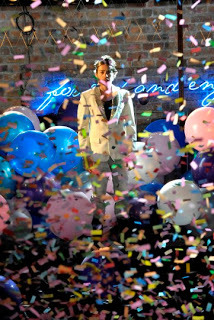 King John is one of Shakespeare's lesser known plays and hardly ever performed. So, being big WS fans here and going to lots of the plays at Stratford, which is an hour's drive from where we live, we booked tickets ages ago.
King John is one of Shakespeare's lesser known plays and hardly ever performed. So, being big WS fans here and going to lots of the plays at Stratford, which is an hour's drive from where we live, we booked tickets ages ago.Is it a History, a Tragedy? Well, according to the RSC's latest production at the Swan theatre, it is a Musical Comedy. (This is the Coronation scene that opens the second half - to the left. Indeed it is John's second coronation, showing how shaky he knew his claim to the throne was).
The play is a great piece of Tudor propaganda, with a scene in which John defies the Papal legate and is very rude about the Pope, declaring himself head of England's church. Pretty anachronistic for around 1200, don't you think? But Henry the Eighth's daughter was on the throne at time and the play was apparently more popular in its time than now, precisely because it showed the King of England standing up to the Pope in Rome.
Another echo can be found in John's (a Bad King, if you remember your Sellars and Yeatman) plan to murder the son of his older brother, which can't help but recall Richard the Third and his alleged murder of his nephews, the young Princes in the Tower - that last monstrous straw which made the reign of Richard Crookback unacceptable and encouraged the young Earl of Richmond to make his push and kill the King at Bosworth Field. The victorious Richmond became Henry the Seventh, Queen Elizabeth's grandfather.
It's not a great play and I doubt very much the new dating of it to 1596, which would make it fall between Richard the Second and The Merchant of Venice. The part of Constance, little Prince Arthur's mother seems an obvious dry run for Margaret of Anjou in the Henry the Sixth plays. (Constance was admirably played by Susie Trayling at Stratford).
And then we come to The Bastard. "He" is the older son of Sir Robert Faulconbridge (deceased) who comes before the king to have the question of inheritance settled, since "his" younger brother is claiming their father's lands, through the terms of the father's Will. But the Bastard (clue is in the name) is well-known to be the illegitimate "son" of Richard the Lionheart, the king's older brother. And shows it in his features, as the shock of of the magnificent Siobhan Redmond, playing Elinor, the king's mother (Eleanor of Aquitaine), at seeing "him" is supposed to underline.
Why all the inverted commas?
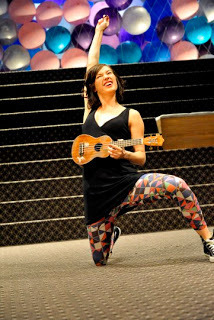 Because this (on the right) is how the RSC has chosen to cast the Bastard, the older son remember. Pippa Nixon. She opens the production, in her mini-dress and patterned tights, with this tiny guitar, plucking out the notes of Land and Hope and Glory and encouraging the audience to join in, saying she "didn't know the words."
Because this (on the right) is how the RSC has chosen to cast the Bastard, the older son remember. Pippa Nixon. She opens the production, in her mini-dress and patterned tights, with this tiny guitar, plucking out the notes of Land and Hope and Glory and encouraging the audience to join in, saying she "didn't know the words.""Kill me now," were the words on my mind. I don't blame Pippa Nixon, who made the best fist of the job she had been so inappropriately given. The Director, Maria Aberg, is responsible for this decision, which makes total nonsense of the inheritance scene. If the Bastard had been female, she would of course have had no claim to her father's lands even if she had been legitimate, at the beginning of the thirteenth century.
It also introduces an entirely spurious quasi-romance between the king and the Bastard (his nephew or even his niece, if you must), when she decides to forgo the disputed lands and throw in her lot as the enthusiastic follower of John.
Now, I'm sorry to harp on about history - and indeed Shakespeare allows himself plenty of anachronism in this play - but King John got his own crown by the Will of Richard the First, his brother, which leapfrogged the claims of young Arthur. In the play, King John finds in favour of the Bastard, flouting the terms of the older Faulconbridge's Will, while wearing the crown King Richard's Will had given him.
These subtleties are quite lost when the Bastard is played by a woman.
But this is not the only bright Directorial idea to cast its blighted shadow over the play. The Papal Legate (who really did excommunicate John in 1209) is played by Paola Dionisotti. She looks wonderful (sadly the RSC website offers only a tiny low-res picture) and acts most of the rest of the cast off the stage. But she is supposed to be a Cardinal, ffs. This is what the "dramaturg" Jeanie O'Hare says about casting a woman as a cardinal of the Church in Rome at the beginning of the thirteenth century: "Again we are bringing the spirit of the Church rather than the dry truth of the role onto [sic] the stage. This is not a political statement about women priests. This is a formidable intervention from someone who can destabilise this world of warring monarchs - and what better way to heighten the sense of Catholic impudence than by having a woman order these two kings around?"
(Essay in the programme).
This is worth quoting at length so that you can see how mind-boggling ignorant are the "ideas" behind this production. There was no "Catholic Church" in 1209. How can you "destabilise" two kings already at war? etc. etc. But this is presents itself as a lively modern interpretation of the play where to do what Shakespeare wrote becomes "dry truth." I really hope the new RSC supremo, Greg Doran, will stop this nonsense.
Of course lots of the audience enjoyed bopping to The Time of my Life and I say a Little Prayer for You, along with the cast. In another context, I might have enjoyed it myself.
Blanche, King John's niece by one of his sisters (another Eleanor) is married off to Louis, the Dauphin of France. And thus the king deflects the French king's support for Arthur's claim to the throne. The wedding of Blanche and Louis is given a full-blown "Hold it, Flash-Bang Wallop, What a Picture!" treatment, with balloons, cowboy hats, stripping, partyhats - the works. Blanche herself (Natalie Klamar) was played very much as Portia and Nerissa were in the "Las Vegas" production of The Merchant of Venice, as a peroxide blonde bimbo in a sticky-out Barbie dress.
But the Merchant of Venice is a popular play, frequently performed. One dud, redeemed by splendid performances by Patrick Stewart and Scott Handy, hardly matters. Who knows when there will be another King John?
I think one of the reasons it hasn't remained as a star of the Shakespeare repertoire is that it isn't really a full-blown tragedy. John has no apparent redeeming features and we don't care when he dies after being poisoned. Prince Arthur's death, which is shown as a suicide leap from castle walls, makes no sense. The Bastard's devotion to the venal king is inexplicable and there is no really great verse to carry it over these defects.
But, just because it's not on a par with Richard the Second - or even Henry the Sixth - is no reason to treat it in this charlatan fashion.
Published on May 13, 2012 11:26
May 9, 2012
A new dawn for Vampires
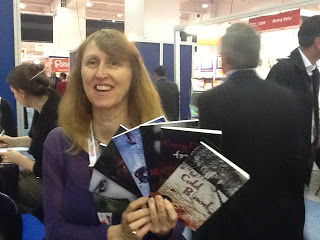 Anne Rooney + vampires at London Book FairI am not a big fan of vampire literature, especially for teenagers. What is now semi-affectionately known as Twiglet casts a long shadow. So it was more in friendship than in preference that I have spent the last two days reading SEVEN YA Vampire books.
Anne Rooney + vampires at London Book FairI am not a big fan of vampire literature, especially for teenagers. What is now semi-affectionately known as Twiglet casts a long shadow. So it was more in friendship than in preference that I have spent the last two days reading SEVEN YA Vampire books.And I loved them! Let me count the ways. I am not a reluctant reader, which is the target audience; I am an avid reader! Then I am hardly a teenager. And as for vampires, I never even read Anne Rice.
But these books are SO skilfully written! I know Anne is a good friend but since I am absolutely not the target audience, I hoped I would count as dispassionate. And I was totally hooked.
There are six short novels and a manual, Bloodsucking for Beginners, all written with much wit and clearly lots of research. The first book, Die Now or Live Forever, should be read first as an introduction to the linked stories of six teens; after that the books can be read in any order. Five teens are camping in a forest in Hungary - have they not SEEN any horror movies? - when they stumble on a young man staked through the chest to the forest floor.
Then they find his murderer, who is not what they expect. Nor is the victim. They then meet the mysterious Ignace, who turns out to be someone we know from history. Actually, quite a few historical figures from the past, some of it quite recent, turn out to be vampires but I won't spoil some of the surprises.
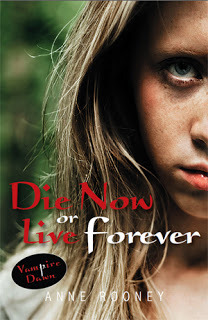
Did you know that after the French Revolution some people sympathetic to the murdered aristocrats wore bow ties bows around their necks? Or that vampires have to stop and count small objects which is why they must avoid weddings and why people throw rice or confetti on those occasions? Neither did I.
Juliette's story, Drop Dead, Gorgeous, is one of the scariest, involving a very nasty scene with a guillotine. But in a way I found Alistair's story, Dead on Arrival, even more palm-sweatingly tense, since he has a hard enough time understanding the world as a teen with Asperger's, let alone being able to cope when he wakes up in a hospital morgue.
Here they all are:
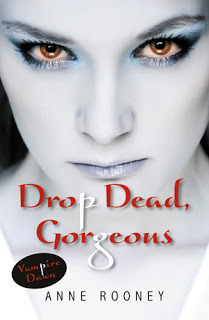
Juliette's story of modelling in Paris, with two stalkers, attempted murder and "that" scene. Why does Juliette never eat? Is it just because she is trying to stay thin for her career? And is it really a good idea for her to fall for Ignace?
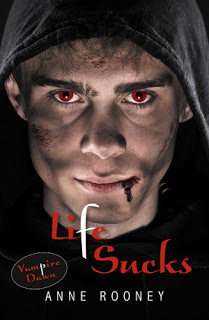
Finn's story, involving a very unexpected vampire, living in a very unexpected place! (In which I am writing this very blogpost. I do NOT go out after dark). Why can't he be as famous and successful a rock star as he seems destined to be?
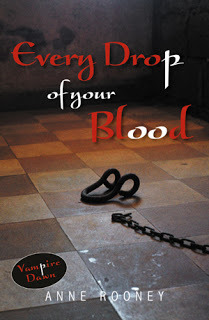
Omar's story, which takes place mainly in Russia. And where the science of vampirism is explained. There are some very unexpected vampires working in the laboratory. And a prisoner you definitely don't want to know about!
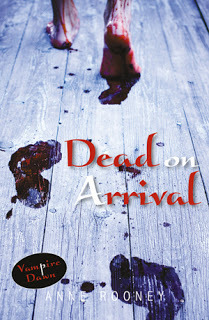
Alistair's story - in many ways my favourite. But very scary! Alistair is Ruby's brother and they share this story. And, since that incident in the Hungarian forest, they share the same destiny too.
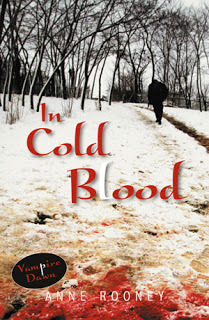
Ava's story, in which another unexpected - and utterly terrifying - vampire shows up. Ava was not one of the original teenagers camping together in Hungary and now she finds herself abandoned in Kosovo, without knowing why.
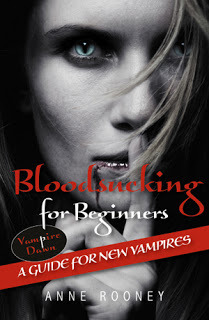
In the manual, you find all sorts of useful advice for the newly-vampirised: ProVamp capsules to stop you lusting after human blood; iVamp, the communication network used by web-savvy vampires; Arithmomania, the counting compulsion you have to get used to; steak - eat it VERY rare!
And so on.
Books for reluctant readers have a limited vocabulary but you feel no sense of that with Vampire Dawn (which has its own website). And writers of such books don't usually see them reviewed in the national press or on prize shortlists.
But remember what Blaise Pascal said: "I have made this letter longer than usual, because I lack the time to make it short." It takes time and care to produce something so short that is grippingly readable.
The Vampire Dawn series is published by Ransom Publishing.
Published on May 09, 2012 13:15
May 3, 2012
Should writers go to Book Fairs?
Published on May 03, 2012 17:01
April 28, 2012
Shakespeare or Hitler?
 The Chandos Portrait, National Portrait Gallery, LondonShakespeare had a birthday this month and so did I. Unfortunately they did not coincide. They would have done if my mother had waited three days. Instead, I share a birthday with Adolf Hitler. In fact one friend who couldn't remember the date, looked up Hitler on the Net to find out when my birthday was. (You see she remembered that coincidence).
The Chandos Portrait, National Portrait Gallery, LondonShakespeare had a birthday this month and so did I. Unfortunately they did not coincide. They would have done if my mother had waited three days. Instead, I share a birthday with Adolf Hitler. In fact one friend who couldn't remember the date, looked up Hitler on the Net to find out when my birthday was. (You see she remembered that coincidence).Another friend emailed "I know your birthday is the same as Hitler's but I always think of it at Shakespeare's" - which was consoling.
But actually no-one knows when Shakespeare was born. He died on 23rd April 1616 and had been baptised 26th April 1564. It was customary to baptise babies within days of their birth in the mid-sixteenth century. Hence the convenience of assigning him one date for the beginning and end of his life.
But who knows? Maybe he was born weak and "peely-wally" like me? (I was born with bronchitis and my lungs are still my weak point). Maybe he could have been born on the same day as I was? Or rather the other way round.
Whatever, I have been enjoying all the Shakespeariana in the media, especially James Shapiro's The King and the Playwright on BBC2 (Mondays at 9pm), which coincides nicely with a period currently interesting me. And Neil McGregor's Shakespeare's Restless World on Radio 4 each day at 1.45pm, where he takes an object as in The World in a Hundred Objects, as a starting point. We've had John Dee's obsidian mirror this week and a model of a bewitched ship - great stuff!
But if I had been born on 23rd April, I would not have been an Aries and I definitely am. Some horoscopes try to tell me Aries stops on 19th but I know better. - "independent, generous, optimistic, enthusiastic, courageous, moody, short tempered, self-involved, impulsive, impatient" says the first website I check and goes on about being ambitious and jealous and not the best mate for a domineering man.
Hmn. Closer to Hitler than Shakespeare, methinks.
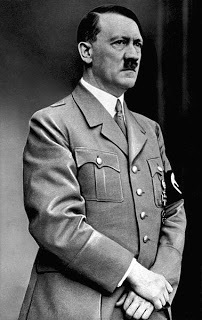
Of course it's all nonsense but I do find myself identifying with these traits. How about you?
Do you share a birthday with someone famous and do you feel happy about it? What about zodiac sign and traits? Can you find anything to identify with there?
Published on April 28, 2012 04:54
April 21, 2012
London Book Fair 2012
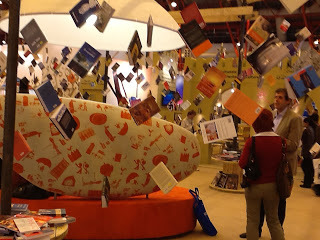 This was my favourite stand at the London Book Fair, where I was Monday to Wednesday. It was from Romania, who were not the official guests, but more of that anon. Cool, isn't it?
This was my favourite stand at the London Book Fair, where I was Monday to Wednesday. It was from Romania, who were not the official guests, but more of that anon. Cool, isn't it?Monday was light for me with a chance to snoop around after coffee with writer friends. (Indeed there was a point where five of us* were Tweeting from smartphones or iPads that we were having coffee together, instead of talking to one another!) Earls Court 1 was very crowded and I heard many stories of people tripping over bits of stands or other people in the melée. I bumped into people myself but in a good way.
I went to a YA seminar chaired by Julia Eccleshare, with Celia Rees and Nick Lake as speakers. Asked whether it was harder to be a teenager now than in the past, Nick Lake said this was a better time to be gay, or black than at earlier periods. "We have exported horror to other countries." But Celia Rees talked about the numerous small choices young people had to make every day.
And Julia Eccleshare made the very good point that, "Big successes drive underground books we know are better."
I had to dash off just as Candy Gourlay was asking a question because I had an hour long session coming up with a publisher, which was very profitable - watch this space.
Monday night saw ten writers, some of whom had been to the Fair and some not, gathered for a Thai meal just off Oxford Street. One man and nine women, which tells you something about writing for children and teens.
Actually it wasn't the first writerly dinner because we had assembled for one on Sunday, just five of us. I went to the Fair with two very good friends. Here is one of them, Lucy Coats, who was making a film on her iPad; I'll add the link when she has put it on her blog.
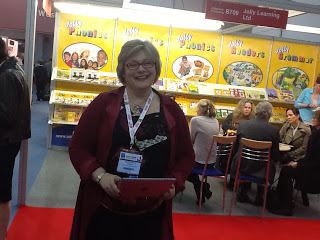
This was right opposite the Illustrators' Bar, where we seemed to start every day with a meeting over coffee. On Tuesday it was Kit Berry of Stonewylde fame. The other good friend, Anne Rooney, dashed off to collect her set of seven Vampire Dawn books (6 novels and a manual, Bloodsucking for Beginners) from the Ransom stand. It was publication day! These are for reluctant readers - no reason why they shouldn't have their own vampire series - and I'll be blogging about them when I've read them.
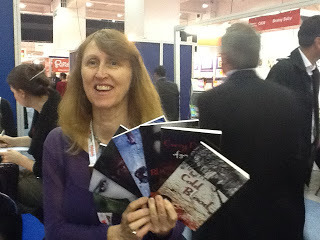
On her way back to the coffee bar, Anne had been accosted by a man with no shirt on who "wanted to give her something." Turned out to be a free copy of E.L.James's bestselling erotic novel, Fifty Shades of Grey. That, unlike the man, has received enough coverage.
Tuesday was my busiest day at the Fair. Meeting with a journalist, lunch with a literary agent and film scout in the US (an old friend), then a very productive meeting with the people at Frances Lincoln. Editor and Art Director as before but now joined by my illustrator for the Great Big Books of .... Ros Asquith.
Then off to a seminar on deafness and disability, with a huge panel of speakers, including Ros and Children's Laureate Julia Donaldson. Had to dash away before the end of that too in order to make the Tweet-up, which was congregating in the - guess where? - Illustrators' Bar. Now, for the benefit of those who don't use this method of communication, a Tweet-up is a meeting in real life of those who know each other on Twitter.
It was fine at the Fair but once the Exhibition Halls closed we all trooped off to a club called the mango Lounge, which was noisy and dark. After one bottle of Prosecco and meeting @FlossieTeacake, who had just been a Twittername to me before, we decamped for a nice Chinese meal and a chat to Lucy's husband, known in her blog as the Wanton Toast Eater. (We did not have Won-ton though).
Back to the Fair on Wednesday for coffee with Celia Rees and a quick dash to secure seats for what we knew would be a popular interview with Patrick Ness. Bagged seats in the front row, with Celia Rees and Beverley Naidoo, Candy Gourlay sitting behind us. Lucy filmed the whole thing and I'm sorry I don't have a photo for you. I was busy "live-Tweeting" the event and making notes so that was quite multi-tasking enough.
Patrick was Author of the Day for Wednesday, a well-deserved honour. His Chaos Walking trilogy won for each successive book, the Guardian Award, The Costa and the Carnegie Medal! His current book, A Monster Calls, his best yet in my opinion, is also shortlisted for the Carnegie and, if I were a betting woman, I'd be off to William Hill for a punt.
Anyway, this was a real highlight with very considered questions from Sunday Times journalist Nicolette Jones and brilliant answers from Patrick. Nicolette questioned him quite closely about the waterboarding scene in The Ask and the Answer and he told us that he often, as an exercise with writing studies, got them to think about someone they loved and then imagine a scene of violence against that person. He said that if there is violence required by the plot, it should always feel as horrible for the reader as if it were happened to someone close to them.
Celia asked how much he knew when he started out on a novel and the answer was "the beginning, the end and three great scenes," adding that all a good book needed was three to five great scenes and no bad ones!
I won't write more about it, as I hope to put a link to the whole talk but he was charming, articulate, modest and intelligent throughout.

Patrick's talk was in Hall 2, where there was also an App Zone and a Digital Zone. Not to mention a Digital Lounge and a Digital Zone theatre. It was clear what the theme of the future was to be, even if agents and publishers were all beavering away in Hall 1 selling Rights on primarily paper books, with electronic Rights as a sort of add-on

The Fair had been preceded by a weekend conference called Digital Minds, where it was predicted that trade e-books sold would overttake hardbacks in 2014 and paperbacks in 1216.
The official guests at the Fair were China but I am not posting a picture of their displays, not of a country where only "approved" writers could come as guests.
Instead I'll finish with a familiar image in a new context. Little, Brown were very proud of their upcoming coup, A Casual Vacancy, the first adult novel by a certain J.K.Rowling, whose image dominated the Hachette stand:
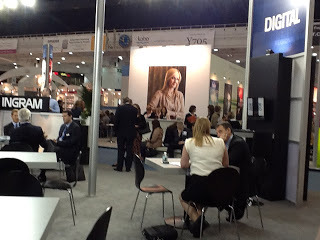
*me, Anne Rooney, Lucy Coats, Nicola Morgan and Gillian Philip.
Published on April 21, 2012 11:42
April 13, 2012
The ?Joy of Writing
 I have been spending a lot of time with other writers lately. First in Bologna then recently in London with three others that spanned three continents of origin. Another the next day, and next week will be full of them, at London Book Fair, at Tweet-ups and social meetings.
I have been spending a lot of time with other writers lately. First in Bologna then recently in London with three others that spanned three continents of origin. Another the next day, and next week will be full of them, at London Book Fair, at Tweet-ups and social meetings.It is however unusual for us to talk about our own writing. Reading other people's, yes. But hardly ever do we talk about the process of our own fiction-making. Agents, editors, money, yes; creation, no.
However, recently I have and it was interesting to hear one person say how much (s)he hated the actual business of writing. It set me thinking. We all know that it can be difficult, that there are days when nothing comes right - or even comes at all.
We all know about the problems that the publishing industry is experiencing currently, and about Internet trolls giving our books horrible reviews on Amazon and elsewhere, sometimes in order to promote their own. We know about the brave Oscar-losers' face we sometimes have to adopt when we experience the opposite of Schadenfreude at our writer friends' successes.
But hating the act of writing itself? I had to think about that.
When it's going well, it's like nothing else in the world, except for ecstatic sex or maybe flying. (NB: Do not try this at home - it rarely happens this way). You have to believe that what you are writing is the best thing since Shakespeare, Dickens, Austen, Proust and Margaret Atwood all rolled into one. (And that's just the first page!).
But here's the mysterious thing. I have experienced writing on a roll and I have known days when it was like pulling teeth from an unanaesthetised crocodile, but how I feel while I'm doing it has no influence at all on how the sentence, the paragraph, the chapter, the whole book itself turns out - none at all!
Watching a writer at work is about as interesting as the traditional pastime of waiting while paint dries, which is presumably why Visconti chose to turn Thomas Mann's Gustav von Aschenbach from a writer into a composer when he made Death in Venice. It gave him a great soundtrack too; what would be the writer's equivalent of the Adagietto from Mahler's Fifth Symphony? From what Facebook tells me, more writers listen to Lady Gaga.
Still, the writer who was lamenting the pain of the job is a good one, whose end results are very satisfactory. It's the process that is agony, not the end product.
So here's a question for those of you who write: is it pleasure or pain, agony or ecstasy?
Published on April 13, 2012 11:11
April 6, 2012
Illegal
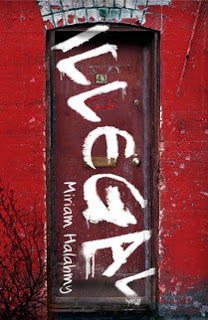 Miriam Halahmy has pulled off a difficult trick - a second novel as good as her first. Hidden dealt with tough topics like illegal immigration and Illegal is just as hard-hitting. But it takes a minor character from the first book and makes her the heroine of the second, an elegant device.
Miriam Halahmy has pulled off a difficult trick - a second novel as good as her first. Hidden dealt with tough topics like illegal immigration and Illegal is just as hard-hitting. But it takes a minor character from the first book and makes her the heroine of the second, an elegant device.The three books set all or partly on Hayling Island form what Miriam Halahmy calls a "cycle" - definitely not a trilogy.
On the face of it, Lindy doesn't have much going for her. Her parents don't work, her two older brothers are in prison and Young Offenders' Institution respectively, her baby sister has died and her younger brother is neglected and needy. Then a cousin offers her easy work watering his plants for cash in hand. Only those plants are a cannabis farm and the cousin is a drug dealer.
Why would you want to read the book after such a synopsis? Well, perhaps because Hidden was a fine début, dealing with a difficult subject in a fresh and positive way. But I can promise if you do pick it up to read you will be totally hooked.
I read it in one long gulp - just over two hours - unable to stop. Yes, Lindy's situation is terrible and getting worse by the minute, since cousin Colin now has her delivering packets of cocaine. Her parents seem quite catatonic since the death of the baby and Lindy doesn't have proper food or clothes. She feels desperately trapped and doomed to follow her brothers into custody.
"That's the trouble with the Bellows family," says school bully Jess. "They're all brain dead."
But we know that Lindy has capabilities, as does her English teacher. It's just that, like so many children, she has had a rotten start in life.
There are two bright points though: first the devotion of her little brother Sean, who is asthmatic and a bit clingy but brings out all Lindy's good qualities of caring and nurturing. Then there is Karl, the elective mute, who is jeered at in school for being a "retard" but is actually intellectually gifted. He and Lindy form a cautious, jumpy alliance and he finds his voice when he sees her in a desperate situation.
This leads to a heart-thumping finale in which Lindy, Karl, Sean and unlikely ally Jess need to act together to thwart the drug dealers, Colin and his sinister tooled-up friend known as Elf because of his pointed ears. It could have been a bit Scooby-Do with a lesser hand guiding the story. But it all works.
And, as with Hidden, there is hope at the end. I imagine these titles are immensely popular with teen readers, because there is no gilding of the lily; Miriam Halahmy was a special needs teacher for many years in London and knows what she is talking about. I'll be looking forward to Stuffed, the third book in the cycle.
Published on April 06, 2012 03:11
March 30, 2012
Bologna Book Fair 2012 Day Three
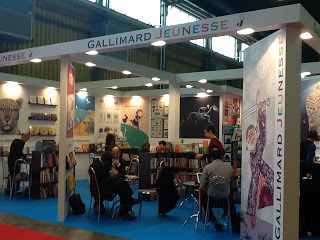
The first party on Tuesday night was given to celebrate Gallimard Jeunesse's 40th birthday and it was where all the beautiful people were. It was in an elegant, frescoed palazzo and the prosecco flowed freely and I met Roger McGough! He was there as a guest of Frances Lincoln, where Janetta Otter-Barry Books publishes his poetry.
After all the dainty canapés, we decamped to the Egmont bash in a nightclub, where I met Tamara MacFarlane, the Indie Bookseller of Tales on Moon Lane and now an author in her own right (Amazing Esme books). She was chatting to Ramez Mikdashi about Magic Town, the new website from Mindshapes Ltd., which offers a "virtual world" for child readers. I got a bit distracted by prosecco but am assured Magic Town is going to be big.
It was not far from this club that we discovered the new favourite watering hole of children's publishers, while the famous "Neon Bar" on Via dell'Indipendenza is still closed. This could have been bad news but we extracted ourselves dextrously.
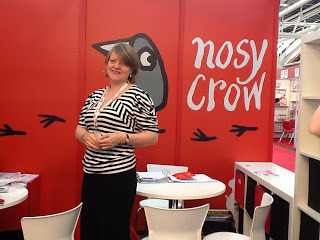 Last day at the Fair and a nice chat with Kate Wilson, above. Nosy Crow has done so very well in three years. I took another picture of its list of awards and they were almost too many to fit in. They were IPG Publisher of the Year last year.
Last day at the Fair and a nice chat with Kate Wilson, above. Nosy Crow has done so very well in three years. I took another picture of its list of awards and they were almost too many to fit in. They were IPG Publisher of the Year last year.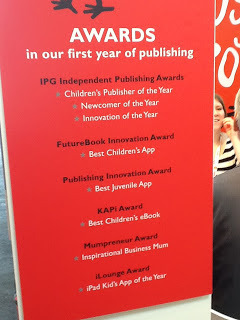 They started with 23 books last year and it's looking like double that it 2013, not to mention the Apps. Their new Frog and Penguin Apps by Emma and Barry Tranter are freestanding, that is they haven't developed out of books.
They started with 23 books last year and it's looking like double that it 2013, not to mention the Apps. Their new Frog and Penguin Apps by Emma and Barry Tranter are freestanding, that is they haven't developed out of books. The Grunts by Philip Ardagh and illustrated by Axel Scheffler are going great guns and I liked the look of The Secret Hen House Theatre a debut by London schoolteacher Helen Peters. And of course Dinosaur oom! Penny Dale's sequel to my favourite from last year, Dinosaur Dig!
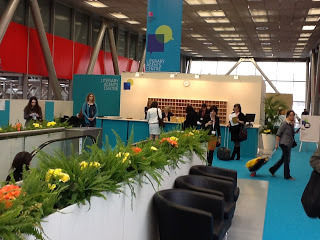
Of course it's not just publishers at the Book Fair. Let's hear it for the agents, who have their own centre up an escalator, their own bar and -yes - their own loos! They work away all day at desks with numbers on flags. The representative from the agency who look after me, Rogers, Coleridge and White, got her own headline in the Bookseller Daily at Bologna: "Claire Wilson sells two débuts to Faber" so you can see how effective thios is.
Her two are Ross Montgomery's Alex and The Cusp and Alexia Casale's The Bone Dragon, both featuring somewhat damaged children.
Illustrators are a very important part of the Fair too anfd this year's special guest was Portugal.
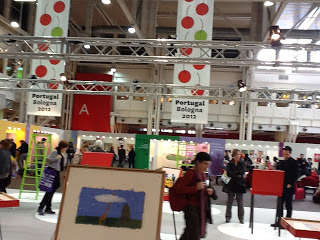
Also spotted were Babette Cole and John Shelley at the SCBWI stand, Korky Paul, who was in Bologna to celebrate Winnie the Witch's 25th anniversary. Another specila guest, for Walker, was Jon Klassen.
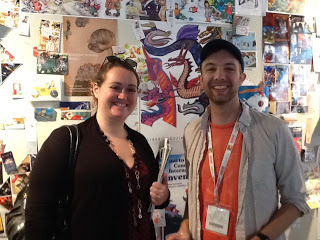
Seen here with Sarah Bennett, Head of Walker's PR, young Mr Klassen is the author Illustrator of best-selling title I want my Hat Back. The sequel, This is not my Hat, will be out in October.
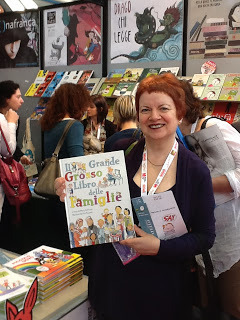
Publishers, agents, booksellers, journalists, illustrators and a sprinkling of authors. Almost my last encounter at the Fair was with the Italian publishers Lo Stampatello, who have brought out Il Grande Grosso Libro delle Famiglie (no translated needed?) and are taking The GBBoFeelings (Emozioni). This photo was one Lucy Coats took earlier. Thanks to her for it and some other photos in these reports.
And so till next year .....
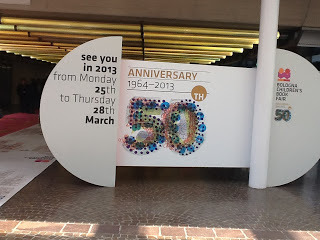
Published on March 30, 2012 17:01
Bologna Book Fair 2012 Day Two

I penetrated the massive new Bonnier stand to see Helen Boyle, Commissioning Editor for Templar. It was quite a contrast to their last year's stand. They even had their own coasters! And a sofa to wait on. "Actually there's a kitchen behind that door," Helen told me.
The Templar fiction list continues strong after the success of H./M.Castor's VIII, with a debut by Claire McFall called Ferryman, the first of three unrelated titles. McFall is a young Glaswegian teacher and her book is a romance set in the afterlife of the girl victim of a road accident, who falls for the man who comes to ferry her across to the other side. Should do well!
But they have not left their illustrated roots behind. Helen was showing two debut picture books at the Fair - Oh dear, Geoffrey! by Gemma O'Neill, about a giraffe and Emma Bennet's Sidney, Stella and the Moon, about best friends. Lovely books but what makes them special is that the artists were two who just turned up at the Templar stand a year ago with their portfolios! It's good to know such magic can still happen.
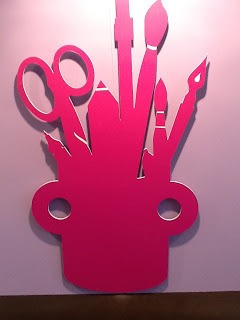
Templar share the Bonnier stand with, among others, Hot Key, whom I promised to say more about. It was a surprise to find Ruth Logan there as Rights Director - a recent appointment - since she was still listed in that capacity in the catalogue for Bloomsbury! But never mind, so was Sarah Odedina. Hmn, maybe that Bible is not as reliable as I thought.
I had seen someone carrying a proof copy of Maggot Moon, Sally Gardner's first book for Hot Key, and craved one. Ruth promised to send me one and gave me a promotional bag in consolation; she needed all her proofs for publishers rather than mavens. And there seems to be an auction building for it in Germany.
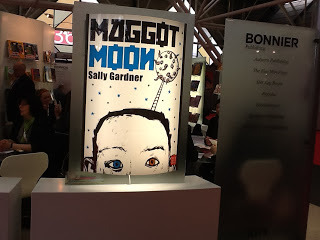
That's a futuristic title but others on offer feature the Spanish Civil War and World War Two. I was pleased to see new titles from Ellen Renner (Tribute) and Rebecca Lisle (The Spin). It's an eclectic and interesting-looking list, which I shall watch with interest.
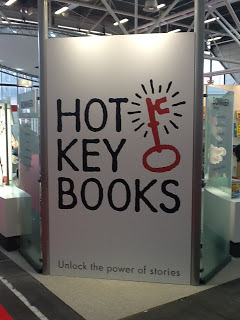
I had lunch with my Finnish publishers, overlooking the Illustrators' Café, where this year's ALMA (Astrid Lindgren Memorial Award) was being announced. We heard the roar but it took a while to find out it was Guus Kuijer, the Dutch writer.
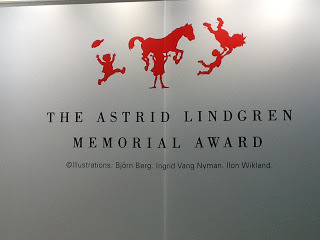
To Bloomsbury next where
I had a super presentation from Ian Lamb (Head of Children's Publicity) and Susannah Curran (Head of Children's Marketing) on a neat little netbook. Is this a new trend, for marketing and PR people to come to the Fair? Nicky Potter was there for Frances Lincoln too.
Throne of Glass by Sarah Maas is their lead title, a debut fantasy from a twenty-five year old American (don't you just hate her already?) about a female assassin in a tournament against male opponents, out in August in the UK. Pre-publication there will be four e-novellas to set readers up for the main book.
Other highlights are a YA edition of Pigeon English, Eleven, Eleven, a WW1 book by Paul Dowswell, whose Auslander did so well. For the younger age range a 6th Septimus Heape book from Angie Sage and The Mystery of Wickworth Manor by Elen Caldecott.
Incredibly, this July sees the fifteenth anniversary of the release of Harry Potter and the Philosopher's Stone and the quest to find the biggest HP fan. The ultimate winner gets a family trip to Wizarding World. It's also the tenth anniversary of Neil Gaiman's Coraline and the book will come out in a new edition illustrated by Chris Riddell.
It's always odd to whip off one hat and put on another at the Fair but with Ian, Susannah and my editor Emma Matthewson all round the table it was irresistible to talk about how to launch the last (sixth) Stravaganza title, City of Swords. Exciting things in the pipeline.
I was strictly an author for the rest of the afternoon, having a productive meeting with editor and art director Janetta and Jude at the Frances Lincoln stand, going through layouts on The Great Big Book of Feelings.
Two parties scheduled for the Tuesday night, of which more tomorrow!
Published on March 30, 2012 04:09
Mary Hoffman's Blog
- Mary Hoffman's profile
- 591 followers
Mary Hoffman isn't a Goodreads Author
(yet),
but they
do have a blog,
so here are some recent posts imported from
their feed.



